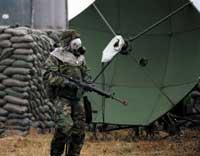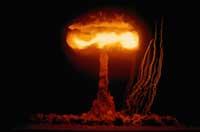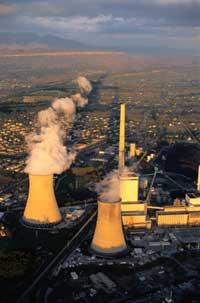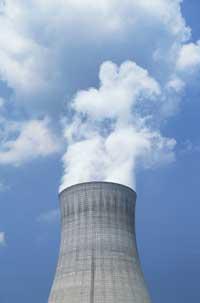From nuclear physics to nuclear energy and atomic bomb

Nuclear physics was born in times of great scientific trust. But since that discovery was destined for military logic rather than its civil use, fear and mistrust have prevailed. However, at the end of World War II, research continued and until the 1980s the nuclear industry has developed in many countries.
The discovery of natural radioactivity was made by Henri Becquerel in 1896 and nuclear physics arose with the work of marriage Pierre and Marie Curie. Initially no harmful effects of radioactivity were known and radioactive elements without control were used. But in 1934, Marie Curie died of leukemia and it was then that they began to suspect that fascinating discoveries could have a hidden and harmful side.
In 1934, Irene and Frederic Joliot-Curie discovered artificial radioactivity and, in the same year, the Italian Enrico Fermi addressed nuclear fission reactions. But these works had to be interrupted by the entry of Europe in World War II.
Military use
As has been said, Europe entered war and, like the rest of areas, had to interrupt scientific research. But not everyone was at war and the witness of nuclear physics research, like many other investigations, was taken by the Americans. By 1942 they had the first nuclear reactor and the first atomic bombs by 1945. They did not have to wait long for the test, since that same year, on August 6 and 9, they were thrown to Hiroshima and Nagasaki, causing 150,000 dead and serious damage that remain evident in the long term. It could not go back, the world was in the atomic age.
By 1952, the United States had a power H bomb prepared a thousand times higher than the bomb dropped in Hiroshima and that eliminates living things without damaging materials. Since then, radioactive elements have been used in most wars, as an essential material to win wars. Depleted uranium weapons, for example, were first used in 1991 in Iraq, and since 1995 in Bosnia and Kosovo in 1999.
As a result, about 300,000 kilos of depleted, radioactive uranium were dispersed in the vicinity of Iraq, Kuwait and Saudi Arabia, with 300 to 800 bullets buried in Iraq and Kuwait. The armies of the United States and England recognized that in the wars of Bosnia and Kosovo 9,000 and 15,000 depleted uranium shells were shot down, respectively.
Mistrust in nuclear energy

With the end of World War II, radioactivity began to develop for civil use. The first reactor to produce energy was destined for the United States electricity grid in 1951. Three years later they were used in Russia, the United Kingdom and France in 1956, Germany in 1961 and Canada in 1962.
In 1999 there were 439 units worldwide, 104 of them in the United States, 58 in France, 53 in Japan, 35 in Great Britain and 29 in Russia. Russia, Canada, Germany, South Korea, Ukraine, Sweden, India, Spain and Belgium are other countries that have opted for this energy. Thus, at present, nuclear energy represents 17% of the world's energy production.
However, since the accident of Chernobil occurred, public opinion is dominated by distrust. After the campaigns of the environmental groups and the ideas spread by many media, the most important part of society is opposed to this energy. The pollution produced by radioactive waste and waste management are currently the main themes of protest. And it seems that this protest is effective because some European countries, including Germany, are on track to exclude nuclear energy.
But, to reach that distrust, it has gone through the black history of the serious disasters that are still being observed today. One of the most decisive days in this history is undoubtedly on April 26, 1986, when the 4th reactor of the Chernobil nuclear power plant exploded. The accidents occurred even before that date of misfortune, although they did not affect the population, they say. The first in 1957 in the central Windscal (Great Britain) and the second in 1979 in the central Three Mile Island (United States). In 1986 there was no solution. All subsequent protective measures were useless. Note the number of cancers and cases of malformation caused by high levels of radioactivity in Ukraine.

But the distrust generated from the accident of Chernobil to the place is not only because the consequences are evident and not disturbing. Russian authorities of the time wanted to hide the accident for a few days, which has only increased their mistrust of nuclear energy. Subsequently, public opinion can be summarized in the following sentence: "We don't understand much, but experts lie."
The case of nuclear waste
In this sense, it is increasingly difficult for those who bet on nuclear defend their position. Although no accident will occur again, the issue of the management of nuclear waste is still pending and, in addition, despite being a problem for many countries, it does not seem that the solution will be found quickly.
Radioactive waste is classified into three groups. They belong to the group A the weakest and least lasting activities (about 30 years). This type of waste is made up of waste from radio isotopes used in nuclear medicine, research laboratories, industries such as paper or steel. Also included are some products used in nuclear power plants (filters, contaminated equipment, clothing, etc. ). These residues, despite 90% of the volume of radioactive waste, do not store more than 10% of radioactivity.
Group B residues are weaker than group C residues, but both are long-lasting (can last millions of years). Among the residues of group C are fission products produced by nuclear fission reactions in nuclear reactors.
These residues are buried so that they are not altered in the expectation of finding the definitive solution. All countries say that the waste problem should not be left for generations to come, but no one has yet found the right solution.
Meanwhile, waste will continue to have much to say, as no one wants their region to become a nuclear waste container.
Many countries back

Public opinion is not supportive of nuclear energy, and although in its day the reactors of great power had become the sign of pride of the country, today less and less governments are committed to this energy. Austria, in 1978, in referendum said no to nuclear. Italy and Switzerland passed extended periods in 1987 and 1990.
Sweden has closed the first plant and plans to close another eleven until 2010. Germany, which currently produces 30% of nuclear power, has announced that it will close all power stations by 2021. In the United States, since the Three Mile Island accident in 1979, the development of this energy has stagnated, but it is still not ruled out.
Japan and France are, therefore, the two main countries that currently continue to bet on this energy. However, even in these countries the opposite opinions have more and more repercussions; in Japan, in 1999, for the accidents that occurred in some fuel production plants, and in France, after the abandonment of the great generator Superphenix, which had been imposed for twenty years.
Published in the supplement Natura de Gara.
Buletina
Bidali zure helbide elektronikoa eta jaso asteroko buletina zure sarrera-ontzian











